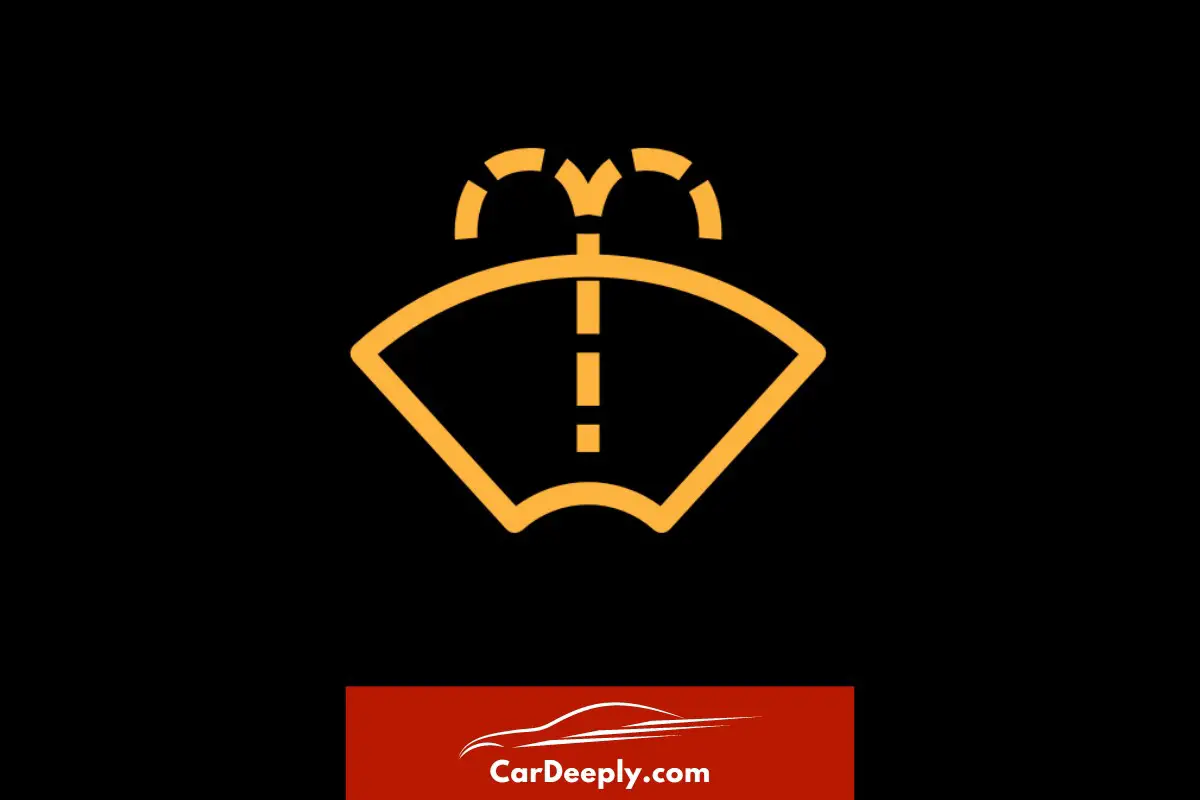Ever been cruising down the road, only to be stopped in your tracks by that pesky washer fluid light? Ignoring it could lead to a blurry windshield and a scary ride. But don’t sweat it! We’re here to guide you through the ins and outs of this little dashboard devil. You’ll learn the following:
- Why that light pops up
- How to refill your washer fluid
- Troubleshooting persistent issues
So buckle up, and let’s dive into the world of washer fluid lights. Trust us, your future self (and your windshield) will thank you!
Advertising links are marked with *. We receive a small commission on sales, nothing changes for you.
Key Takeaways

- The washer fluid light alerts you when your windshield washer fluid is low.
- Ignoring this light can reduce visibility and potentially damage the wiper system.
- Checking and refilling your washer fluid is a simple process that you can do yourself.
- Persistent washer fluid light could indicate sensor or wiring issues, requiring troubleshooting.
- If the light remains on despite troubleshooting, it’s time to seek professional help.
Understanding the Washer Fluid Light
Have you ever noticed that little icon on your dashboard that looks like a water fountain? That’s your washer fluid light. It’s a small but mighty part of your car’s communication system. It tells you when your windshield washer fluid is running low.
Why should you care?
Your windshield is your window to the world when you’re driving. It’s crucial to keep it clean for your safety and the safety of others on the road.
Reasons Why the Washer Fluid Light Comes On
Now, let’s get into the nitty-gritty. Your washer fluid light might be flashing at you for a few reasons.
Low Washer Fluid Level
The most common reason is, you guessed it, a low washer fluid level. Your car is telling you it’s thirsty and needs a refill.
Sensor Issues
Sometimes, the problem isn’t with the fluid level but the sensor that checks it. If the sensor is faulty, it might send you false alarms.
Wiring Problems
Lastly, wiring problems can also trigger the washer fluid light. If the wires connecting the sensor to the dashboard are damaged, the light might come on even when the fluid level is fine.
Consequences of Ignoring the Washer Fluid Light
Ignoring your washer fluid light is like missing a friend’s advice – it might seem okay at first, but it can lead to problems down the line.
Reduced Visibility
The most immediate consequence is reduced visibility. With enough washer fluid, you can effectively clean your windshield. This can be especially dangerous in bad weather or when driving at night.
Potential Damage to the Wiper System
Over time, running your wipers without enough fluid can also damage the wiper system. The blades can wear out faster, and the motor can overheat.
So, the next time your washer fluid light comes on, don’t ignore it. It’s your car’s way of asking for a little TLC. And paying attention to it might save you from a sticky situation on the road!
How to Reset the Windshield Washer Fluid Light
Resetting the windshield washer fluid light might seem daunting, but it’s simple. Here’s a step-by-step guide to help you out.
Step 1: Refill the Washer Fluid
The first step is to refill your washer fluid. Ensure you use the right fluid type for your car and fill it to the indicated level.
Step 2: Check for Sensor Issues
If the light doesn’t go off after refilling, the sensor might have a problem. You can try cleaning it to see if that helps.
Step 3: Inspect the Wiring
Are you still waiting? It’s time to check the wiring. Look for any signs of damage or loose connections.
Step 4: Reset the Light
If everything seems fine, but the light is still on, you might need to reset it manually. This process can vary between car models, so it’s best to consult your car’s manual or seek professional help.
Step 5: Seek Professional Help
Feel free to take your car to a professional if all else fails. They can diagnose and fix the problem to ensure your safety on the road.
Remember, the washer fluid light is there to help you. So, please don’t ignore it. Instead, use these steps to reset it and keep your windshield clean and clear.
How to Check Washer Fluid Level
Ready to roll up your sleeves and get your hands a little dirty? Let’s dive into how to check your washer fluid level.
Locating the Washer Fluid Reservoir
First things first, you need to find the washer fluid reservoir. It’s usually located under the hood of your car, often on the left or right side. Look for a clear or white plastic container with a symbol resembling a windshield or water spray.
Checking the Fluid Level
Once you’ve found the reservoir, take a peek inside. Most reservoirs are transparent or have a gauge, so you can easily see if the fluid level is low. If it’s near or below the minimum line, it’s time for a refill.
Steps to Refill the Washer Fluid
Refilling your washer fluid is as easy as pie. Here’s how you do it.
Choosing the Right Washer Fluid
Before you start, make sure you have the right washer fluid. Some fluids are better for certain weather conditions, so pick one that suits your needs.
Process of Refilling the Washer Fluid
Now, open the cap of the washer fluid reservoir and pour in the fluid until it reaches the maximum line. Be careful to fill it out appropriately. Once you’re done, close the cap securely.
Troubleshooting a Persistent Washer Fluid Light
If your washer fluid light is still on after a refill, don’t panic. Here’s what you can do.
Checking for Sensor Issues
First, check the sensor. It might be dirty or faulty. Cleaning or replacing it might solve the problem.
Inspecting Wiring Problems
If the sensor is fine, inspect the wiring. Look for any signs of damage or loose connections. If you find any, you might need to repair or replace them.
When to Seek Professional Help
If you’ve tried everything and the light is still on, it’s time to call in the pros.
Persistent Light Despite Full Reservoir
A deeper issue might need professional attention if the light stays on even though the reservoir is full.
Signs of Damage to the Wiper System
If you notice any signs of damage to the wiper system, like unusual noises or poor performance, it’s best to get your car checked by a professional.
Remember, your car is like a trusted friend. It communicates with you through lights and signals. So, when your washer fluid light comes on, please don’t ignore it. Listen to it, understand it, and take action. Your car (and your safety) will thank you!
Frequently Asked Questions
Can I use water instead of washer fluid?
While water can be used in a pinch, there are better choices for your windshield cleaning system. Water doesn’t have the cleaning agents that washer fluid has and can freeze in cold weather. So, it’s always best to use proper washer fluid.
How often should I check my washer fluid level?
It’s a good idea to check your washer fluid level every time you fill up your gas tank. This way, you can ensure that you always have enough fluid to keep your windshield clean and clear.
What should I do if my washer fluid reservoir is leaking?
If your washer fluid reservoir leaks, fixing it as soon as possible is important. A leak can lead to a low fluid level, triggering your washer fluid light. Consult a professional to diagnose and fix the problem.
Can a faulty washer fluid sensor affect other parts of my car?
A faulty washer fluid sensor won’t directly affect other parts of your car. However, if it’s causing your washer fluid light to stay on, it can be distracting and potentially dangerous while driving. It’s best to get it checked and fixed if necessary.
How much does it cost to replace a washer fluid sensor?
The cost to replace a washer fluid sensor can vary depending on the make and model of your car. You can expect to pay between $50 and $200 on average. It’s always best to consult with a professional for an accurate estimate.

Sebastian loves convertibles and drove a BMW 335i for a long time (325 hp is just a dream). Today, with two children, he is more concerned with SUVs and family-friendly vehicles. In addition to an Audi A4 Avant, he also drives a Cupra Formentor VZ – even as a family man, you can’t do without speed. Get to know Sebastian better and visit the About Us page.
Advertising links are marked with *. We receive a small commission on sales, nothing changes for you.

